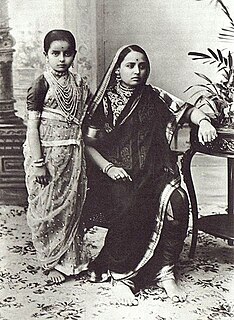
A sari or saree is a women's garment from the Indian subcontinent that consists of an unstitched drape varying from 4.5 to 9 yards in length and 600 to 1,200 millimetres in breadth that is typically wrapped around the waist, with one end draped over the shoulder, partly baring the midriff. It is traditionally worn in the countries of India, Pakistan, Bangladesh, Sri Lanka and Nepal. There are various styles of sari manufacture and draping, the most common being the Nivi style. The sari is worn with a fitted bodice commonly called a choli and a petticoat called ghagra, parkar, or ul-pavadai. It remains fashionable in the Indian Subcontinent today.
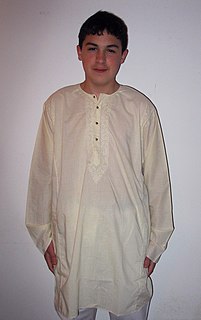
A kurta is a loose collarless shirt worn in many regions of South Asia, and now also worn around the world. Tracing its roots to Central Asian nomadic tunics, or upper body garments, of the late-ancient- or early-medieval era, the kurta has evolved stylistically over the centuries, especially in South Asia, as a garment for everyday wear as well as for formal occasions.

A blouse is a loose-fitting upper garment that was worn by workmen, peasants, artists, women, and children. It is typically gathered at the waist or hips so that it hangs loosely ("blouses") over the wearer's body. Today, the word most commonly refers to a girl's or woman's dress shirt. It can also refer to a man's shirt if it is a loose-fitting style, though it rarely is. Traditionally, the term has been used to refer to a shirt which blouses out or has an unmistakably feminine appearance.
Clothing in India is dependent upon the different ethnicities, geography, climate, and cultural traditions of the people of each region of India. Historically, male and female clothing has evolved from simple garments like kaupina, langota, achkan, lungi, sari, well as rituals and dance performances. In urban areas, western clothing is common and uniformly worn by people of all social levels. India also has a great diversity in terms of weaves, fibers, colours, and material of clothing. Sometimes, color codes are followed in clothing based on the religion and ritual concerned. The clothing in India also encompasses the wide variety of Indian embroidery, prints, handwork, embellishment, styles of wearing clothes. A wide mix of Indian traditional clothing and western styles can be seen in India.
Kantha also spelled kanta, and qanta, is a type of embroidery craft in the eastern regions of India, particularly in the Indian states of West Bengal, Tripura and Odisha as well as in Bangladesh. In Odisha, old saris are stacked on each other and hand-stitched to make a thin piece of cushion. This is normally used above a bed cushion or instead of a cushion. "Kantha saris" are traditionally worn by women in Bengal region of the India. In these days, embroidery is stitched, popularly known as 'kantha stitched", on sari, kurta and churidar and many other garments and gaining popularity due to their aesthetic value and handmade characteristics.

Zari is an even thread traditionally made of fine gold or silver used in traditional Indian, Bangladeshi and Pakistani garments, especially as brocade in saris etc. This thread is woven into fabrics, primarily silk, to make intricate patterns and elaborate designs of embroidery called zardozi. Zari was popularised during the Moghul era, the port of Surat was linked to the Meccan pilgrimage route which served as a major factor for re-introducing this ancient craft in India. During the Vedic ages, the gold embroidery was associated with the grandeur and regal attire of gods, kings, and literary figures (gurus){as shown in the movies}.

A choli is a blouse or a bodice-like upper garment that is commonly cut short leaving the midriff bare, it is worn along with a sari in the Indian subcontinent. The choli is also part of the ghagra choli costume in the Indian subcontinent.
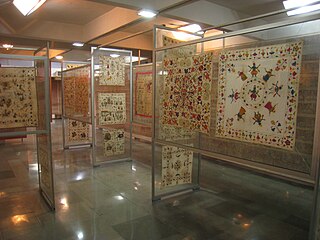
Embroidery in India includes dozens of embroidery styles that vary by region and clothing styles. Designs in Indian embroidery are formed on the basis of the texture and the design of the fabric and the stitch. The dot and the alternate dot, the circle, the square, the triangle, and permutations and combinations of these constitute the design.
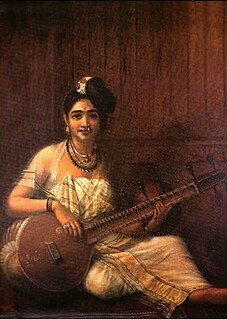
Mundum neriyatum is the traditional clothing of women in Kerala, a state in southwestern India. It is the oldest remnant of the ancient form of the sari which covered only the lower part of the body. In the mundum neriyatum, the most basic traditional piece is the mundu or lower garment which is the ancient form of the sari denoted in Malayalam as tuṇi, while the nēriyatu forms the upper garment the mundu. The mundum neriyatum consists of two pieces of cloth, and could be worn in either the traditional style with the nēriyatu tucked inside the blouse, or in the modern style with the nēriyatu worn over the left shoulder.

Mekhela Sador is an indigenous traditional Assamese dress traditionally worn by Assamese women.
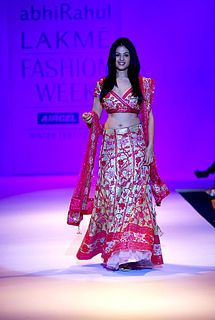
The lehenga, lehnga or langa is a form of ankle-length skirt from the Indian subcontinent. Different patterns and styles of traditional embroidery are used to decorate the lehenga. Gota patti embroidery is often used for festivals and weddings. The lehenga is sometimes worn as the lower portion of a gagra choli or langa voni. Ghagra in Hindi, was also used to refer to the half slip or petticoat, a skirt worn as an undergarment below the sari. In wedding ceremonies around northern and central part of India, lehengas are the prime costume of a bride. Many varieties of bridal lehengas can be found in such weddings.

Khmer traditional clothing refers to the traditional styles of dress worn by the Khmer people from ancient times to the present.
A langa voni is a traditional dress worn in South India by young girls between puberty and marriage. It is also known as the two-piece sari or half sari. Young girls between puberty and marriage wear this dress. Girls younger than this may wear it on special occasions.

Ghagra choli,, is a type of ethnic clothing for women from Indian Subcontinent, notably in the Indian states of Rajasthan, Gujarat, Madhya Pradesh, Uttar Pradesh, Bihar, Haryana, Punjab, Himachal Pradesh, Uttarakhand, Jammu and Kashmir, as well as in the Pakistani provinces of Punjab and Sindh. In Punjab, the lehenga is traditionally worn with a kurti. It is a combination of the gagra or lehenga and the choli (blouse), however in contemporary and modern usage lehenga choli is the more popular and widely accepted term by fashion designers, trend setters, and boutiques in South Asia, since ghagra is synonymous with the half-slip worn as an undergarment below the sari.

The Kaashtha sari is a style of sari draping is very similar to the way the Maharashtrian dhoti is worn. The word Kaashtha refers to the sari being tucked at the back. Since this sari is usually worn by using a single nine yard cloth, it is also referred to as Nauvari which means Nine Yards. Sakachcha sari is another term commonly used to refer to this style of sari. It is referred to as Akanda Vastra, which means it doesn't need any other attire to support it. In fact, this attire holds utmost importance as women across different walks of life have worn it. It is not just worn at religious and cultural events, but women have fought wars in the past and still work in farmlands wearing this.

Indian wedding clothes are elaborate set of clothes worn by the bride, bridegroom and other relatives attending the wedding.

Croatian national costume, also called as Croatian traditional clothing or Croatian dress, refers to the traditional clothing worn by Croats living in Croatia, Bosnia and Herzegovina, Serbia, with smaller communities in Hungary, Austria, Montenegro, and Romania. Since today Croats wear Western-style clothing on a daily basis, the national costumes are most often worn with connection to special events and celebrations, mostly at ethnic festivals, religious holidays, weddings, and by dancing groups who dance the traditional Croatian kolo, or circle dance.

Sindhi women wear the Ghagra Choli or the sari and the men wear the shalwar kameez or the kurta with pyjamma. However, before the adoption of the Shalwar kameez, the sari and the kurta, Sindhi's had their own traditional costumes.

History of clothing in the Indian subcontinent can be traced to the Indus Valley civilization or earlier. Indians have mainly worn clothing made up of locally grown cotton. India was one of the first places where cotton was cultivated and used even as early as 2500 BCE during the Harappan era. The remnants of the ancient Indian clothing can be found in the figurines discovered from the sites near the Indus Valley civilisation, the rock-cut sculptures, the cave paintings, and human art forms found in temples and monuments. These scriptures view the figures of human wearing clothes which can be wrapped around the body. Taking the instances of the sari to that of turban and the dhoti, the traditional Indian wears were mostly tied around the body in various ways.
Kurti top is an upper garment worn in the Indian subcontinent encompassing waistcoats, jackets and blouses.
















